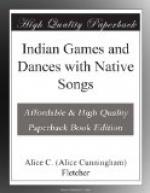The He-de Wa-chi
AN OMAHA FESTIVAL OF JOY
INTRODUCTORY NOTE.—For centuries the home of the Omaha tribe has been in the region now known as the State of Nebraska, north of the city which bears their name. There they dwelt in permanent villages, surrounded by their garden plots of corn, beans, squashes, etc. From these villages every year in June all the tribes except the sick and infirm went forth to follow the buffalo herds in order to obtain their supply of meat and pelts. As this tribal hunt was essential to the needs of the life of the people, it was a very serious affair, initiated with religious ceremonies and conducted under strict rules enforced by duly appointed officers. It was at the close of this great tribal hunt, when food and clothing had been secured, while Summer lingered and the leaves had not yet begun to fall, so that brightness was still over the land, that this Festival of Joy took place. Like all Indian ceremonies, the He-de Wa-chi embodied a teaching that was for the welfare of the tribe, a teaching drawn from nature and dramatically enacted by the people. The Omaha tribe was made up of ten distinct groups, each one having its own name, a set of names for those born within the group, and certain religious symbols and ceremonies committed to its care. By tribal rites and regulations these ten distinct groups were welded together to form the tribe, whose strength and prosperity depended upon internal harmony and unity.
The He-de Wa-chi taught the people what this unity really stood for. The central object of the ceremony was a tree, which was the symbol of the tribe; its branches were as the different groups composing the tribe, the twigs that made up the branches were as the individuals that formed the groups.
The Omaha had special ceremonies for the preparation of the central object. They cut a tree, left a tuft of branches at the top and painted the trunk in alternate bands of red and black. The red bands represented day, the black, night; the decoration as a whole stood for the continuity of life. This pole was planted in a broad open space. As the melodious Call to the Ceremony echoed over the land, the people gathered from their tents. Each one of the ten groups took its respective place and all the groups formed a wide circle about the tree. Every one, down to the little children, carried a twig with leaves. These they held aloft as they made their rhythmic, ceremonial approaches to the tree, and afterward danced about the sacred symbol.
It was a wonderful and a beautiful scene that took place on the prairies years ago, when hundreds of Omahas moved to the rhythm of the sacred songs, waving the green sprays as they danced up to the symbolic tree and circled about it with thanksgiving and joy. It was thus they exemplified tribal unity, wherein every one was a part of the living whole.




